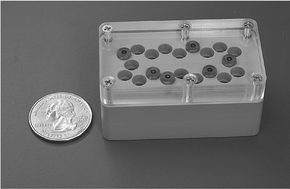This paper presents the first systematic engineering study of the impact of chemical formulation and surface functionalization on the performace of free-standing microfluidic polymer elements used for high-pressure fluid control in glass microsystems. System design, chemical wet-etch processes, and laser-induced polymerization techniques are described, and parametric studies illustrate the effects of polymer formulation, glass surface modification, and geometric constraints on system performance parameters. In particular, this study shows that highly crosslinked and fluorinated polymers can overcome deficiencies in previously-reported microvalve architectures, particularly limited solvent compatibility. Substrate surface modification is shown effective in reducing the friction of the polymer–glass interface and thereby facilitating valve actuation. A microchip one-way valve constructed using this architecture shows a 2 × 108 ratio of forward and backward flow rates at 7 MPa. This valve architecture is integrated on chip with minimal dead volumes (70 pl), and should be applicable to systems (including chromatography and chemical synthesis devices) requiring high pressures and solvents of varying polarity.

You have access to this article
 Please wait while we load your content...
Something went wrong. Try again?
Please wait while we load your content...
Something went wrong. Try again?


 Please wait while we load your content...
Please wait while we load your content...